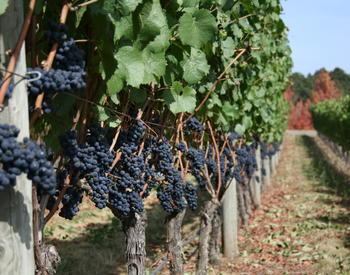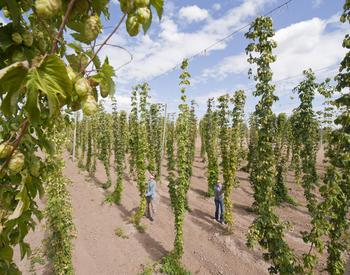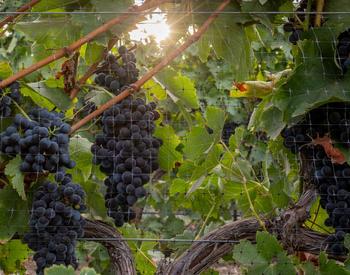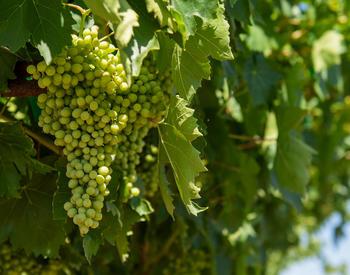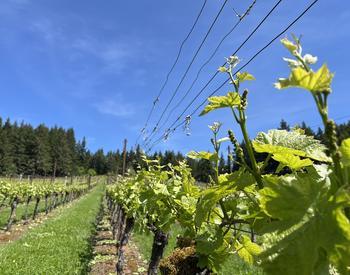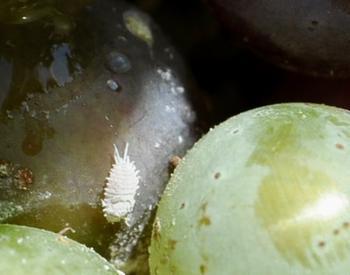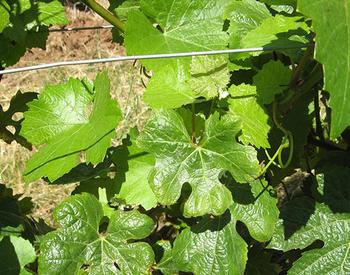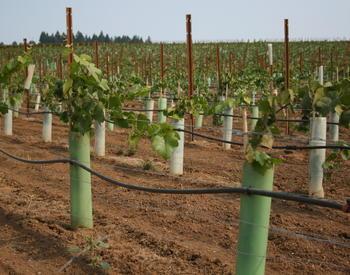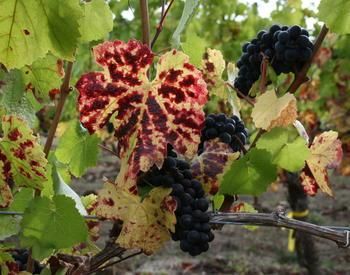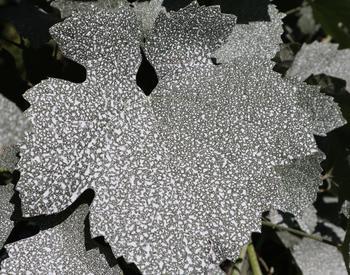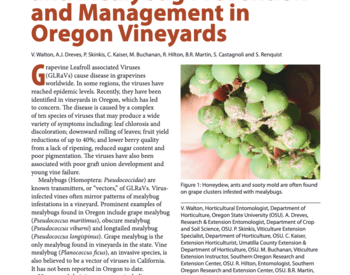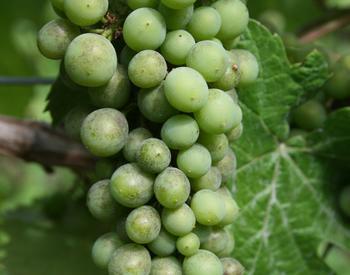As harvest nears each year, there are many things to prepare for before the fruit starts arriving at the winery. One subject on the "to-do" list is grape maturity testing and planning for pre-fermentation adjustments that may be required. The standard grape compositional measurements are pH, titratable acidity (TA) and Brix. Additional parameters such as yeast assimiliable nitrogen (YAN) and malic acid may also be measured close to picking or once fruit is in the tank.
Often it is a simple process to use these chemical parameters to determine your pre-fermentation adjustments. However, in some years, fruit composition does not line up with expectations or unexpected changes occur during fermentation that may cause challenging wine chemistries. An increased understanding of these basic grape compositional components can help better predict what pre-fermentation adjustments may be needed and how they may affect wine chemistry parameters.
Sampling matters
Taking a representative sample for analysis is the first critical step when assessing grape composition. Vineyard sampling strategies should be developed that reflect the block that will be harvested and minimize bias that could lead to over- or underestimated grape composition parameters. When taking grape and juice samples for analysis, the more closely these samples represent the grape and juice in the tank, the better.
When assessing red grapes, I recommend taking the grape samples and crushing them by hand in a resealable plastic bag and letting the juice soak on the skins for a few hours in the fridge. This will give you a more accurate pH value, because the grape skins contain a significant amount of potassium that will soak out during this time. If you analyze the juice immediately after crushing the grapes, you will not account for this potassium. Grape skins also contain some amino acids and dried/shriveled grapes will release more sugar after soaking which will give a better estimation of the Brix and YAN content of the grapes. If conducting a cold soak, sampling at the end of the soak will give the most accurate values on which to base any adjustments.
Sugar and potential ethanol
Brix values are typically used to estimate potential ethanol of the finished wine, but this value is not equal to fermentable sugars (glucose and fructose) which can lead to over- or underestimation of potential ethanol. In some years, Brix may line up perfectly with glucose + fructose but in other years, there may be some variance (often Brix will be lower than combined Glu + Fru measures). Measuring glucose and fructose will give a more accurate ethanol estimate. Calculate this measure using the following formula:
(Glucose g/L + Fructose g/L) / 16.83 = Potential ethanol (% v/v)
Other factors that can affect ethanol concentration include the following:
- Yeast strain: Saccharomyces cerevisiae strains may vary in ethanol yields, and some non-Saccharomyces yeasts consume some sugar but do not produce ethanol.
- Fermentation temperature: Higher temps can lead to slightly lower ethanol.
Do you need to measure both pH and titratable acidity?
Acidity, as measured by pH and TA, is a critical grape parameter that affects wine microbial stability, sulfur dioxide effectiveness, color, potassium bitartrate stability, and taste. pH and TA are not the same and measuring both is important to give you a better overall understanding of grape acidity, potential changes that may occur during wine production and adjustments that may be required.
The major acids in grapes are the weak acids — malic and tartaric acid. Small amounts of citric acid may also be present, but this has minimal impact on pH and TA. Both malic and tartaric acid are dicarboxylic acids, meaning they have two carboxylic acids groups. When measuring titratable acidity, you are measuring the total amount of dissociated and undissociated ions in solution. Because both malic and tartaric acid both have two carboxylic acid groups, changes in the ratio of malic to tartaric acid are not reflected in the TA as the contribution of dissociated and undissociated ions from either acid is the same.
On the other hand, changes in malic to tartaric ratio will impact pH. The pH is a measurement of acid strength (concentration of free H+ ions in solution) and tartaric acid is a stronger acid than malic acid. This means that you can have grapes or wine that have the same TA but different pH values due to differences in malic and tartaric acid content.
The malic acid concentration of the grapes will also affect how much of a pH shift occurs post malolactic fermentation, as the dicarboxylic malic acid is metabolized to the monocarboxylic lactic acid (a weaker acid). Large pH shifts can occur during malolactic fermentation (MLF) if you have high malic acid content in your grapes/wine. Malic acid concentrations vary from year to year, so measuring malic acid in the grapes will give you a better understanding of how pH may shift during MLF and what pre-fermentation acid adjustments may be necessary.
The impact of potassium on acidity
pH and TA can also be affected by the concentration of the cation potassium (K+). K+ is naturally present in grapes and is an essential nutrient. In the grape, a H+ ion on tartaric acid can be substituted for a K+ ion, resulting in the formation of potassium bitartrate (KHT) (Figure 1). This can lead to a raise in the pH, as there is a decrease in the free H+ ions in solution due to the substitution of a K+ ion.
In general, higher K+ concentrations will result in higher pH, but this relationship does not always exist. K+ has less of an impact on TA, as TA measures both dissociated (free) and dissociated ions while pH measures only free H+. In practice, this can lead to TAs and pH values that do not correlate as you would expect. For example, a juice having a higher pH than you would expect given the high TA.
There can also be situations where there is both a high TA and a high pH due to the extent of K+ substitution and formation of KHT. In the berry K+ increases during ripening and changes during grape processing and fermentation. Grape skins contain K+, so soaking the grapes on the skins will increase K+. Pressing also impacts K+, with harder pressing resulting in higher K+ content. During fermentation, there will likely be an initial increase in K+ due to extraction from the grape skins, but then concentration starts to decrease as KHT forms and begins to precipitate out. This will remove a H+ ion and result in an increase in pH. The TA will also increase.
K+ has an impact on the effectiveness of acid additions to juice/grapes and wine. An addition of tartaric acid may initially increase the TA, but if there is high K+ then the formation of KHT may not result in the expected decrease in pH. Furthermore, as KHT precipitates (during fermentation and cold stabilization) the removal of tartaric acid will then decrease the TA. The impact of tartaric acid on pH is dependent on the juice/wine pH. When tartaric acid is added, it dissociates into three forms:
- Tartaric acid (H2T)
- Bitartrate (HT-)
- Tartrate (T=).
The proportion of each present is determined by the pH of the juice, grapes or wine (Figure 2). At pH < 3.65, a large amount of tartaric acid is present as H2T. The formation of KHT (reaction of HT- and K+) will release an H+ ion causing a decrease in pH (Figure 2). The precipitation of KHT removes tartaric acid and will therefore result in a decreased TA. Due to the loss of KHT, the equilibrium will be balanced by the dissociation of more H2T which will release more H+ ions and further decrease pH.
In summary, at pH <3.65, a tartaric acid addition will decrease pH and decrease TA as KHT precipitates (Figure 2). However, at pH values >3.65, pH and TA react differently to a tartaric acid addition. At pH >3.65 tartaric acid exists predominately as the HT- ion. When the HT- ion reacts with K+ ions to form KHT, the tartaric acid is lost due to precipitation (resulting in a decrease in TA). As before, the equilibrium needs to be balanced due to the loss of KHT but at this higher pH, this results in the formation of HT- through the reacting of H+ ions with T=. This results in the consumption of a H+ ion and an increase in pH.
So, in wines at pH >3.65, KHT precipitation results in a decrease in TA and an increase in pH. In practice, if you are starting with a high pH juice/must it can be difficult to reduce your pH later in the process because your tartaric acid additions will not be effective. Acid additions pre-fermentation should be targeted at getting you pH <3.50 so that post-MLF your wine will still likely be below pH 3.65 and responsive to further acid adjustments. While TA values may be initially high, KHT precipitation and cold stabilization will later reduce your TA.
Feeding your yeast for a healthy fermentation
Aside from the basic juice chemistry parameters, it is also important to know the concentration of yeast assimilable nitrogen (YAN) so that suitable adjustments can be made if necessary. YAN is composed of nitrogen from ammonia (inorganic nitrogen) and nitrogen from primary amino acids (organic nitrogen). Once determined, YAN adjustments should be based on a target YAN value. While you want to add enough YAN for a complete and clean fermentation, you do not want to add excessive nutrients, as this can also cause problems such as overly vigorous fermentations and altered aroma compound production by the yeast.
How much yeast assimilable nitrogen do you need?
Well, it depends. The general recommendation is between 150-250 mg/L for a 21-23°Brix must. If you have a higher °Brix must or are using a high nutrient demand yeast strain, then you may want to consider higher YAN levels. These are not hard and fast rules but are YAN levels that have been reported by researchers and yeast manufacturers to result in fermentations with good kinetics.
Aside from nitrogen, the other nutrients that are essential factors for yeast growth are the micronutrients such as the vitamins biotin, pantothenic acid, and thiamin. If you just want to increase YAN, then ammonia (DAP) is an efficient way to do so. However, DAP does not contain any micronutrients, so you also should be sure to use a complex yeast nutrient that contains a blend of organic nitrogen (amino acids, peptides) and micronutrients. A balanced approach of both DAP and complex nutrients works best if you need to significantly increase your YAN levels. Nutrient additions should be carefully monitored and recorded, as there are legal limits (concentrations) that can be added for DAP (0.96 g/L), thiamin (0.60 mg/L), and pantothenic acid (0.048 mg/L). For complex yeast nutrients, carefully read the manufacturer’s instructions to determine the maximum concentration of the product that can be added.
The timing of nutrient additions is important for successful fermentations. Yeast preferentially uptake DAP before amino acids. Therefore, one large addition of DAP at the beginning of fermentation may delay or inhibit uptake of amino acids and cause problems later in fermentation. For this reason, perform multiple additions of nutrients during the early to mid-fermentation stage.
For example, add half the nutrients 12–24 hours after inoculation followed by the remainder of the nutrients around 1/3 sugar depletion. Adding nutrient supplements all at once can lead to a fast fermentation rate, and an imbalance in uptake and usage of nitrogen compounds. Alternatively, supplements added too late in the fermentation (after 2/3 fermentation) may not be utilized by the yeasts. This is because as the fermentation proceeds, ethanol concentrations reach a point where they impact the yeast membrane and reduce the ability of the yeast to take up nutrients.
Overview
- Representative samples (vineyard or winery) are key to useable data.
- Brix, pH and YAN may change due to soaking on skins.
- Glucose + Fructose concentrations are the most accurate parameter for estimating potential ethanol.
- pH and TA measure different components of acidity.
- Potassium concentration can impact pH due to formation of potassium bitartrate.
- pH shifts due to potassium bitartrate precipitation may increase or decrease pH depending on initial pH. pH <3.65 = decrease in pH while pH >3.65 = increase in pH.
- YAN assessment is important to determine appropriate nutrient additions.
- Balance of DAP and complex yeast nutrients are recommended to provide YAN and micronutrients to the ferment.
- Nutrients added late in fermentation are unlikely to be utilized by yeast. Perform additions early and at 1/3 fermentation.
